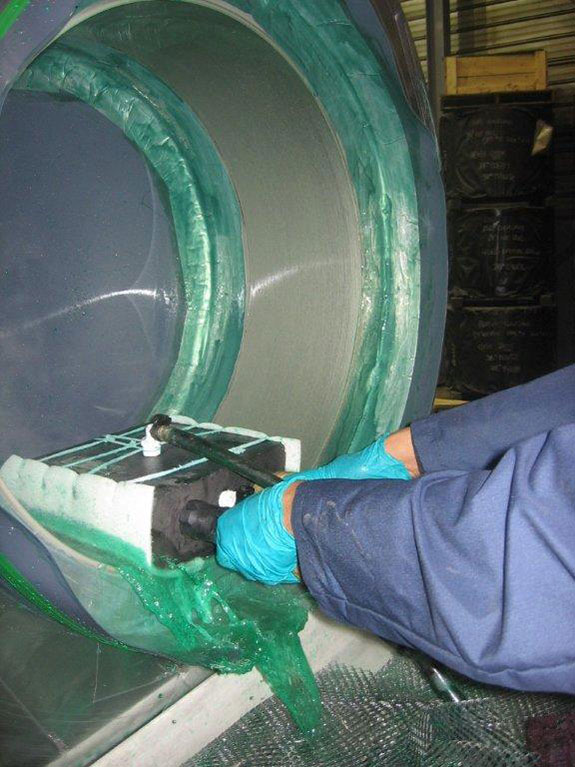Localising a surface solution for O&G applications
Published by David Bizley,
Senior Editor
Oilfield Technology,
Applying engineered surface coatings can provide a wealth of benefits including protection against corrosion and wear. Derek Vanek of SIFCO Applied Surface Concepts (ASC), part of Norman Hay plc, and a leading supplier of selective plating technology and solutions, discusses the application benefits and possibilities of selective plating for the oil and gas industry.
There are many benefits to choosing selective plating, including the ability to accurately focus the plating onto specific areas of a component, enabling parts to be plated in-situ, helping to minimise downtime and production delays. This is particularly beneficial in an industry, which has very large components, that can be difficult to transport, and where every hour of downtime can be highly costly. In contrast to tank plating, the SIFCO Process® does not require extensive masking or special fixtures to plate the component and deposits can be plated at rates that are 30 to 60 times faster than conventional tank plating.
The SIFCO Process® should not just be considered for repair or salvage. The full range of pure metal and alloy deposits available with the SIFCO Process® offer enhanced wear resistance, increased surface hardness, low electrical contact resistance or corrosion protection for OEM component applications.
The oil & gas industry is highly demanding of material performance, often operating in hostile, challenging environments, where the cost of downtime resulting from component failure can be extremely high. The SIFCO Process® is well proven, and extensively utilised, within the oil & gas industry in a wide range of applications from OEM component manufacture, to provide enhanced wear or corrosion resistance, to repair, where the process portability is important in reducing expensive downtime.
One common application is silver plating onto dynamic sealing and bearing surfaces within drill bit components for lubricity.
Another common application is the use of selectively plated copper onto premium threaded connections, for drill pipes, risers, tubulars, and couplings in order to prevent galling during make-and-break operations.
For oil & gas producing operations, there is no escaping the challenge of corrosion due to the harsh marine and subsea environment. The properties of AeroNikl make it an extremely popular material to be selectively plated in highly corrosive applications such as high-chloride down-hole applications. Additionally surfaces that are mechanically damaged are often plated with a combination of copper and AeroNikl.
An example of such a repair carried out in-situ with the SIFCO Process® was the repair of critical damage – caused by a lightning strike – to a crown mounted compensator (CMC) on an oil rig in the Gulf of Mexico. The CMC is responsible for applying constant tension to the drill string and to compensate for any rig movement. The significant gouge on the cylinder caused by the lightning strike would cause severe leakage at the cylinder seals, threatening production and the loss of thousands of dollars for each hour of downtime.
Using SIFCO ASC’s AeroNikl® 7280 for corrosion protection and Cobalt 2043 to cap the repair for hardness and to protect against surface wear, the CMC was back in full operation within 24 hours – saving potentially three months downtime to replace the shaft.

Ensco 8505 drilling rig in the Gulf of Mexico.
A typical operation using the SIFCO Process®
The SIFCO Process® was developed more than 50 years ago, and was initially used for industrial repair applications, with early acceptance by the US Navy. Over the years, the SIFCO Process® was developed to service a wide range of industrial repair and manufacturing applications.
The range of metals used in selective plating is extensive. The SIFCO Process® is used to apply any metals that are traditionally carried out by tank electroplating, the most common being; nickel, copper, cobalt, nickel-tungsten, cobalt chromium carbide, silver, gold and platinum.
The process can be carried out manually, it can be mechanised, or it can be automated for high volume applications. The thickness of the plating is accurately controlled through use of an ampere-hour meter and once the required ampere hours are reached, plating is stopped and finished with a final water rinse and dry.

Inside diameter repair applying AeroNikl® on a component for wear resistance.
Automating the process for high volume
We recently developed a semi-automated workstation for Powell Electrical Systems Inc., a division of Delta/Unibus, which reduced the processing time to selectively plate non-cyanide silver onto each side of its copper bus bars by 90%.
Its portability and versatility has allowed the SIFCO Process® to be employed in some of most challenging locations and applications around the world including oil rigs in remote locations, submarines and space stations.
The various advantages provided by the SIFCO Process®, combined with the wide range of engineered deposits, make it an attractive choice for OEM and repair applications. Whatever the requirements or size of a job, selective plating should always be considered a viable alternative to other methods of metal deposition.
More information on the SIFCO process is available here.
Adapted by David Bizley
Read the article online at: https://www.oilfieldtechnology.com/special-reports/26112015/localising-a-surface-solution-for-oandg-applications/
You might also like
EnerMech secures two-year cranes extension in North Sea
The current agreement, which began in August 2022, will now run until at least August 2027.

